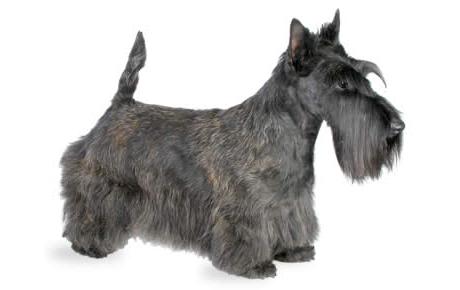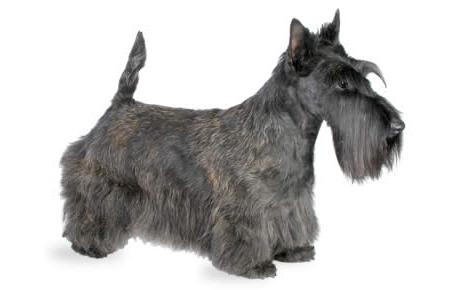- Breed Category: Terrier
- Country of Origin: Scotland
- Average Height: 25-28 cm; 10-11 inches
- Average Weight: Males 8.5-10 kg; Females 8-9.5 kg; 18-22 lbs
- Average Life Span: 12-15 years
- Grooming Requirements: Regular brushing and trimming
- Exercise Requirements: Moderate daily exercise needed
- Coat Type: Dense, wiry outer coat
- Coat Color Variations: Black, wheaten, brindle
- Shedding Level: Low
- Ear Type: Erect
- Tail Type: Medium length, carried high
- Temperament: Independent, confident, alert
- Intelligence Level: High
- Barking Tendency: Moderate
- Compatibility with Children: Good with older children
- Compatibility with Other Pets: May chase smaller animals
- Training Ease: Can be stubborn
- Common Health Issues: Von Willebrand’s disease, allergies
- Dietary Needs: High-quality dog food recommended
- Energy Level: Moderate
- Drooling Tendency: Low
- Sensitivity to Weather: Sensitive to heat
- Overall Maintenance Level: Moderate
- Original Purpose: Hunting vermin and small game
- Year of Recognition by Kennel Clubs: 1885
- Famous Breed Representatives: Fala, President Roosevelt’s dog
- Apartment Friendly: Yes, with sufficient exercise
- Best Suited For: Active families, singles, seniors
- Cost of Ownership: Moderate
- Unique Traits: Distinctive beard and eyebrows
- Cultural Significance: Symbol of Scottish heritage
- Popularity Rank: Moderate
Did you know that the Scottish Terrier, affectionately known as the “Scottie,” has been a beloved companion for over 150 years? This iconic breed, with its distinctive beard and bushy eyebrows, is not just a pretty face. Scotties are known for their independent spirit and loyalty, making them a favourite among dog enthusiasts. In this article, we’ll dive into the fascinating history of the Scottish Terrier, explore their unique characteristics, and provide insights into their care. Whether you’re considering adding a Scottie to your family or simply want to learn more about this charming breed, you’ll find everything you need to know right here. Let’s get started on this journey into the world of the Scottish Terrier.
History and Origin of the Scottish Terrier

Early Development of the Breed
The Scottish Terrier, or “Scottie,” has roots that trace back to the rugged landscapes of Scotland. Originally bred to hunt vermin, these dogs were prized for their tenacity and courage. Their development began in the 19th century, with breeders focusing on creating a dog that was both sturdy and spirited. The Scottie’s distinctive appearance, with its wiry coat and sharp features, was carefully cultivated during this time.
Role in Scottish History and Culture
Scotties have played a significant role in Scottish history and culture. They were not just working dogs but also symbols of Scottish pride. Their image has been associated with the Scottish identity, often appearing in art and literature. The breed’s popularity soared as they became a favourite among Scottish nobility, further cementing their place in the cultural tapestry of the region.
Key Historical Figures
Several key figures were instrumental in the creation and popularisation of the Scottish Terrier. One notable individual was Captain Gordon Murray, who was pivotal in refining the breed’s characteristics. His dedication to maintaining the Scottie’s unique traits helped establish the breed standard that enthusiasts admire today.
Physical Characteristics of the Scottish Terrier
Appearance
Scottish Terriers are small but sturdy dogs, typically weighing between 8 to 10 kilograms. Their compact size is complemented by a dense, wiry coat that comes in a variety of colours, including black, wheaten, and brindle. This coat not only gives them a distinctive look but also provides protection against the harsh Scottish weather.
Distinctive Markings
One of the most recognisable features of the Scottie is its iconic beard and bushy eyebrows. These distinctive markings give the breed a wise and somewhat dignified appearance, setting them apart from other terriers. Their sharp, alert eyes and erect ears add to their expressive face, making them quite the head-turner.
Unique Physical Traits
Beyond their striking facial features, Scotties have a robust build with a deep chest and short legs, designed for digging and hunting. Their tail, often carried upright, adds to their confident stance. This combination of traits makes the Scottish Terrier not only a charming companion but also a dog with a rich history of purpose and function.
Temperament and Behaviour of the Scottish Terrier

Typical Personality Traits
Scottish Terriers are known for their independence and confidence. They carry themselves with a dignified air, often displaying a strong sense of self. Despite their small size, Scotties are bold and fearless, traits that have been honed over generations. Loyalty is another hallmark of the breed, as they form strong bonds with their families and are often very protective.
Suitability as a Family Pet and Watchdog
Scotties make excellent family pets, especially for those who appreciate a dog with character. Their loyalty and protective nature make them natural watchdogs, alerting their owners to any unusual activity. While they are affectionate with their families, they can be reserved with strangers, which adds to their effectiveness as a watchdog.
Interaction with Children and Other Animals
When it comes to children, Scotties are generally good companions, though they may prefer older kids who understand their independent nature. Early socialisation is key to ensuring they get along well with other animals. While they can coexist with other pets, their strong prey drive means they might not be the best fit for homes with small animals like rabbits or guinea pigs.
Training and Exercise Needs of the Scottish Terrier

Importance of Early Training and Socialisation
Scottish Terriers, with their independent streak, benefit greatly from early training and socialisation. Introducing them to various environments, people, and other animals at a young age helps mould a well-rounded adult dog. This early exposure is crucial in curbing any potential stubbornness and ensuring they grow into confident companions.
Recommended Training Techniques
When it comes to training, positive reinforcement is the way to go. Scotties respond well to treats, praise, and play. Consistency is key, as their independent nature can sometimes lead to selective hearing. Short, engaging training sessions work best, keeping their attention and making learning fun.
Daily Exercise Requirements and Activities They Enjoy
Scotties are energetic little dogs that need regular exercise to stay happy and healthy. A daily walk, combined with some playtime in a secure yard, usually suffices. They love activities that engage their minds, like puzzle toys or games of fetch. Digging is in their DNA, so providing a designated digging area can be a great outlet for this natural behaviour.
Health and Lifespan of the Scottish Terrier

Common Health Issues
Scottish Terriers, like many purebred dogs, can be prone to certain health issues. They are known to have a higher risk of developing conditions such as Scottie cramp, a movement disorder, and von Willebrand’s disease, a blood clotting disorder. Regular vet check-ups are essential to catch any potential problems early.
Average Lifespan and Health Tips
On average, a healthy Scottish Terrier can live between 11 to 13 years. To help them reach their full lifespan, a balanced diet and regular exercise are crucial. Keeping their weight in check can prevent joint issues, while mental stimulation keeps them sharp and happy.
Preventative Care Recommendations
Preventative care is key to maintaining a Scottie’s health. Regular dental cleanings, vaccinations, and flea and tick prevention should be part of their routine care. Additionally, grooming their wiry coat helps prevent skin issues and keeps them looking their best. A little effort goes a long way in ensuring your Scottie stays healthy and vibrant.
Grooming and Maintenance of the Scottish Terrier

Coat Care and Grooming Routines
Scottish Terriers boast a dense, wiry coat that requires regular grooming to keep it in top condition. A weekly brush is essential to prevent matting and tangles, while a professional trim every few months helps maintain their iconic look. Pay special attention to their beard and eyebrows, as these areas can trap dirt and debris.
Shedding and Seasonal Grooming Tips
Scotties are considered low shedders, but they do experience some seasonal shedding. During these times, more frequent brushing can help manage loose hair and keep your home tidy. Regular grooming not only keeps their coat healthy but also provides an opportunity to check for any skin issues or parasites.
Incorporating these grooming habits into your routine ensures your Scottie remains comfortable and looking sharp. A well-groomed Scottie is not just a joy to behold but also a testament to the care and attention they receive from their owner.
Diet and Nutrition for Scottish Terriers

Nutritional Needs for Optimal Health
Scottish Terriers thrive on a balanced diet that supports their energetic nature and robust health. High-quality dog food, rich in protein, is essential to maintain their muscle mass and energy levels. Look for foods that include whole meats or meat meals as the primary ingredient, along with a good mix of vegetables and grains for fibre and vitamins.
Foods to Include and Avoid
Incorporate lean meats, fish, and eggs into their diet for protein. Vegetables like carrots and peas can provide essential nutrients. Avoid foods high in fat and sugar, as these can lead to obesity and other health issues. Steer clear of chocolate, grapes, and onions, as these are toxic to dogs.
Feeding Schedules and Portion Recommendations
Scotties do well with a consistent feeding schedule. Two meals a day, morning and evening, are ideal. Portion sizes depend on their age, weight, and activity level, but generally, 1 to 1.5 cups of dry food per day is a good starting point. Always adjust portions based on your dog’s specific needs and consult with your vet for personalised advice.
Fun Facts and Trivia about Scottish Terriers
Interesting Tidbits about the Breed
Scottish Terriers, or “Scotties,” are more than just their iconic looks. Did you know they were originally bred to hunt foxes and badgers? Their strong prey drive and digging skills are a nod to their working dog heritage. Despite their small stature, Scotties have a big personality, often described as “a big dog in a small body.” They are known for their independence and can be quite stubborn, which adds to their charm.
Famous Scottish Terriers in Media or History
Scotties have made their mark in history and pop culture. One of the most famous Scotties was Fala, President Franklin D. Roosevelt’s beloved pet, who even has a statue at the Franklin Delano Roosevelt Memorial in Washington, D.C. In the world of animation, Jock from Disney’s “Lady and the Tramp” is a classic Scottie character, showcasing the breed’s distinctive look and spirited nature. These dogs have certainly left their paw prints on history and in our hearts.
Final Thoughts

The Scottish Terrier is a symbol of independence and loyalty. With their distinctive appearance and spirited nature, Scotties offer both charm and companionship. While they require dedicated grooming and training, the rewards of having a Scottie as a family member are immense. Their rich history and unique traits make them a fascinating breed for dog lovers. Consider welcoming a Scottie into your home and experience the joy of this iconic breed.
